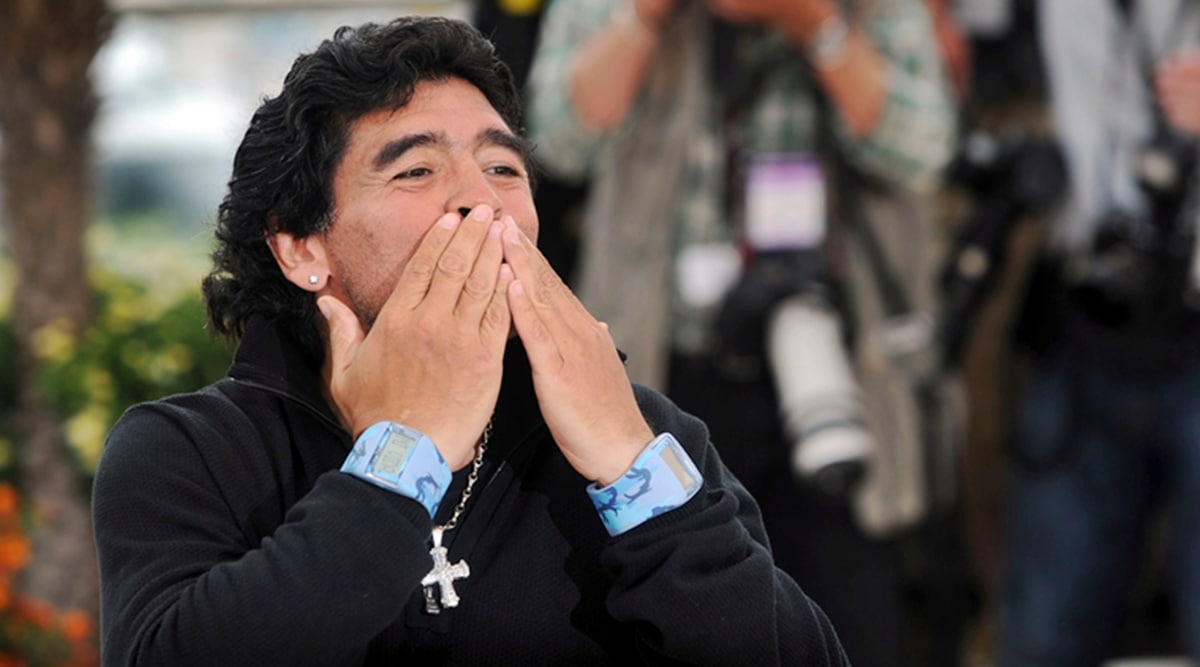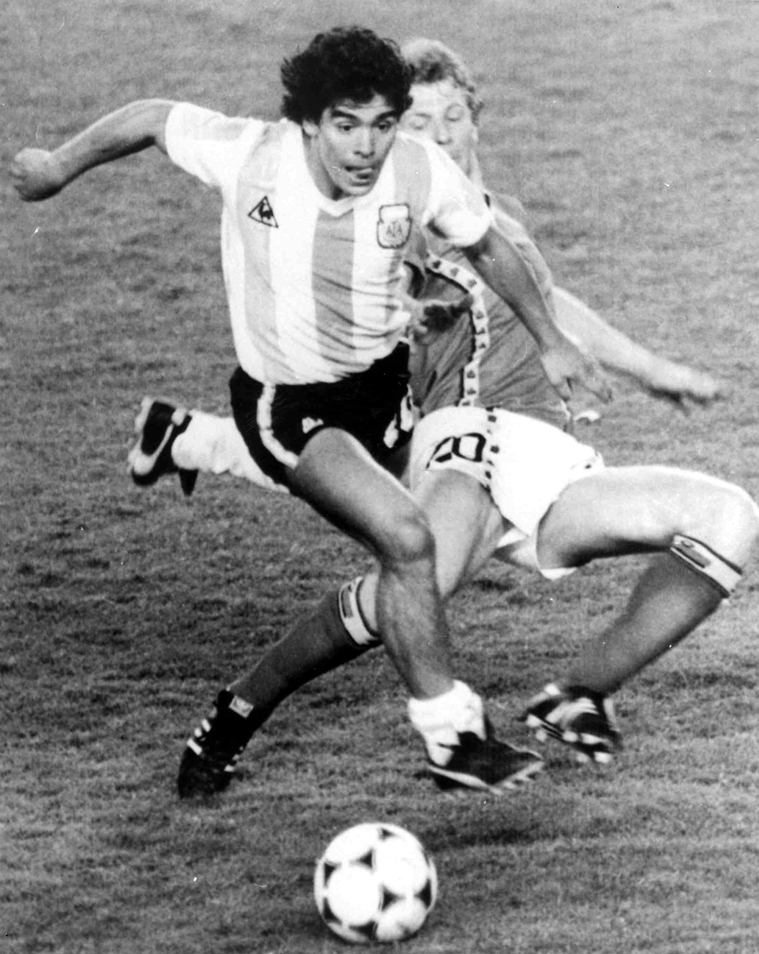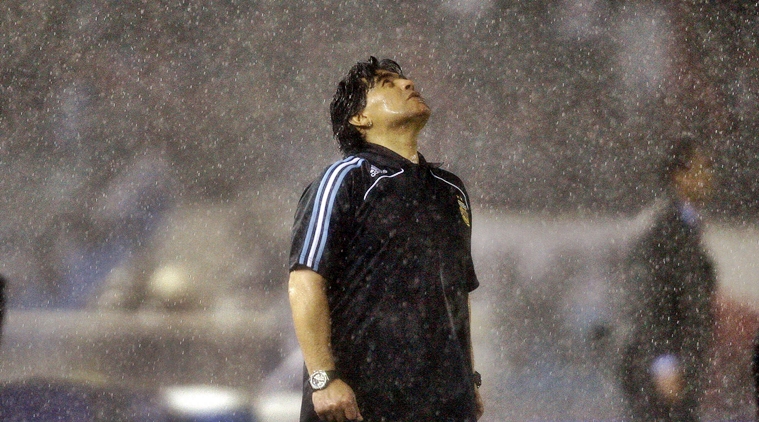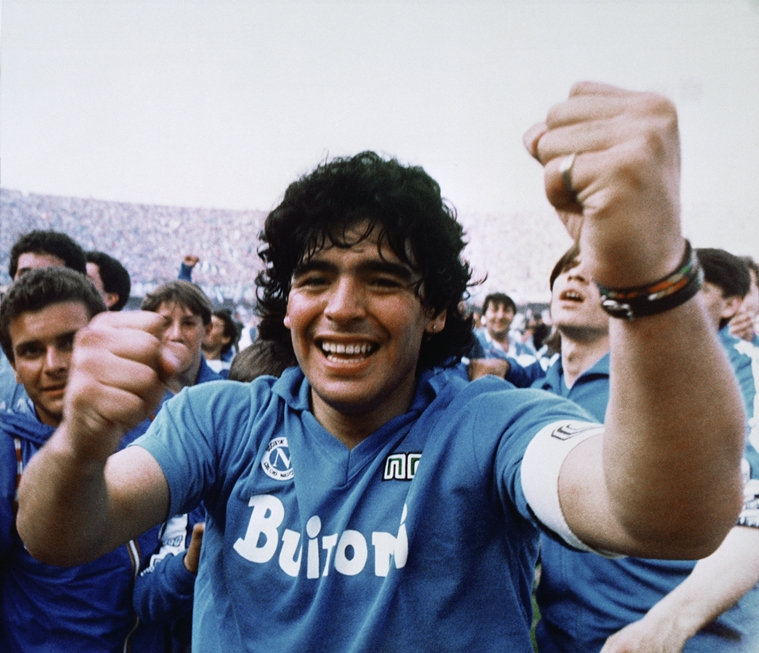 Diego Maradona blows a kiss to fans in Cannes, France, on May 20, 2008. (AP)
Diego Maradona blows a kiss to fans in Cannes, France, on May 20, 2008. (AP)Napoli beatified Diego Maradona. In the end, the ‘sewer of Italy’, that Naples was called in the 1980s, contaminated him to the core. Maradona’s time at the club in southern Italy was full of contradictions. It was in fact, the football genius’ life in microcosm.
The arrival
In 1984, Maradona made the move to Napoli from Barcelona for a then world record fee of £5 million. “I expect peace. The peace I didn’t have in Barcelona,” Maradona said in Asif Kapadia’s 2019 documentary Diego Maradona.
 In this June 13, 1982 file photo, Argentina’s Diego Maradona, front, is attacked by Belgium’s Guy Vandermissen during the opening game of the Soccer World Cup in Barcelona, Spain. (AP)
In this June 13, 1982 file photo, Argentina’s Diego Maradona, front, is attacked by Belgium’s Guy Vandermissen during the opening game of the Soccer World Cup in Barcelona, Spain. (AP)
A turnout of 85,000 welcomed him at Stadio San Paolo on July 5, 1984. It was chaotic. A reporter was thrown out of the press conference for his temerity to ask about Camorra, the feared mafia. Napoli as a club was a backbencher in Italian football, with only two Cups in their trophy cabinet until 1984 and never a Scudetto (Serie A title).
Life in Naples
“I asked for a house, I got a flat. I asked for a Ferrari, I got a Fiat,” Maradona said in the documentary. On the pitch, Napoli were a relegation-threatened side in 1984. Like the city, the football club, too, was rated as second-class by the Northerners – an assortment of rich people from Milan, Turin and other well-off cities in Italy. But things started to change. Juventus, the reigning European champions, were beaten at San Paolo during Maradona’s second season. Napoli were on the rise, finishing third in the league. Maradona was at the heart of the upturn.
First-ever Scudetto
On May 10, 1987, history was made. It was Napoli’s first-ever Serie A title. They got there by securing 42 points from 30 matches – two points were awarded for a win back then. Serie A was the richest league in the world then. Most of the big stars plied their trade there.
 FILE – In this Oct. 10, 2009 file photo, under the pouring rain, Argentina’s coach Diego Maradona looks up under the pouring rain during a 2010 World Cup qualifying soccer match against Peru, in Buenos Aires. Argentina won 2-1. (AP)
FILE – In this Oct. 10, 2009 file photo, under the pouring rain, Argentina’s coach Diego Maradona looks up under the pouring rain during a 2010 World Cup qualifying soccer match against Peru, in Buenos Aires. Argentina won 2-1. (AP)
The 1986-87 season was also the great Juve master Michel Platini’s swansong. It became a footnote. Maradona scored 10 goals, provided countless assists and almost singlehandedly carried his team to the title. “The social redemption of our city,” Maradona’s team mate Ciro Ferrara said in the documentary. Maradona became Naples’ patron saint. A shrine was built.
Other honours
Napoli would win their second league title in 1989-90. In 1989, they annexed the Uefa Cup and the Italian Super Cup a year later. The Copa Italia was won in 1987. Between 1984 and 1991, Maradona made 188 appearances for Napoli and became the club’s all-time leading goal-scorer with 115 goals, a record that stood until 2017. In an interview with MARCA, legendary AC Milan and Italy defender Franco Baresi had this to say about Maradona: “… if I had to choose the strongest opponent, I’d say Maradona.”
The big fall
Throughout the summer of 1989, rumours were rife that Maradona would leave Napoli for Marseille for another undisclosed world-record fee. In August that year, he failed to attend a training camp and alleged that the local mafia was threatening him. According to Maradona, he had a gentleman’s agreement with the club authorities that he would leave after the 1990 World Cup. Maradona had alleged that Napoli reneged on the promise, causing a serious mental setback that took him to drugs. He would play at weekends, go on a drug binge on Mondays before returning to training mid-week. In 1991, he was banned after a test showed traces of cocaine. His 15-month suspension ended in 1992.
 Argentine soccer superstar Diego Armando Maradona cheers after the Napoli team clinched its first Italian major league title in Naples, Italy, on May 10, 1987. (AP)
Argentine soccer superstar Diego Armando Maradona cheers after the Napoli team clinched its first Italian major league title in Naples, Italy, on May 10, 1987. (AP)
By then, Maradona was a pale shadow of his past. He gained weight and became slow. Kapadia’s documentary chronicled his fall through excerpts from a wire-tapping operation. The drug ban brought down the curtain. “When I arrived, there were 85,000 there to greet me. When I left, I was alone,” Maradona said in the documentary.